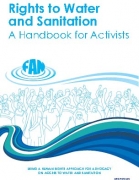Storage and Supply
CIVIC , City-level debate on Water, 21st February 2011, 3 - 5 pm, SCM House, Bangalore
Posted on 21 Feb, 2011 11:28 AMOrganizer: Citizen's Voluntary for the city of Bangalore
Venue: SCM House, Mission Road, Bangalore
Topics:
- Overall picture of water supply - population v/s availability - present and future
- Increasing BWSSB efficiency - plans for reducing 50% unaccounted water
Study of ancient water storage systems on forts in Nashik district of Maharashtra - Paper presented at the National Seminar on Water and Culture (2007)
Posted on 14 Feb, 2011 05:11 AMThis paper studies the water supply, distribution, collection and storage in the forts around Nashik with the idea of testing the viability of implementing such systems in areas of similar topography. The history of forts in Maharashtra and the forts around Nashik and the water collection and distribution systems thereof are described.
Water management in the Vijaynagar empire - Paper presented at the National Seminar on Water and Culture (2007)
Posted on 14 Feb, 2011 01:55 AMThis paper focuses on water management techniques used in two tanks constructed by the kings of the Vijaynagar Empire.
The first example taken, is that of the Anantraj Sagar built by the son of the minister of Harihar. The lake is still in use and there are inscriptions on stone near it which provide a thumb rule to constructing lakes. Construction of this lake began in 1369 and was completed in 2 years. The paper states that the length of the dam was 5000 dand, width was 8 dand and the height was 7 dand (One dand is about one metre).
Water management systems in the coastal area of Ratnagiri, with special reference to water tanks near temples - Paper presented at the National Seminar on Water and Culture (2007)
Posted on 14 Feb, 2011 01:27 AMThis paper discusses the water management systems found in temples in coastal Konkan, based on a study of 5 temples in the district of Ratnagiri. The study area is a rocky and rugged country, with elevated plateau and intersecting creeks.

Private water supply, sanitation and hydropower projects and reforms projects involving privatisation and commercialisation in India - Database by Manthan Adhyayan Kendra
Posted on 31 Jan, 2011 11:16 PMThe database has been developed as a part of Manthan Adhyayan Kendra's engagement in comprehensive monitoring, research and analysis of policies, programs and projects relating to privatisation/commercialisation of water sector.
Right to water and sanitation - A handbook for activists by Freshwater Action Network (FAN) Global
Posted on 31 Jan, 2011 10:11 PM With tihs, they can improve water and sanitation service regulation and provision at international, national and local levels. Directed primarily at community groups, human rights NGOs, rights-based development practitioners and aid workers, this handbook aims to strengthen human rights-based advocacy by providing innovative and practical suggestions that activists and organisations can use in their work. It also acts as a resource guide for finding further information.
With tihs, they can improve water and sanitation service regulation and provision at international, national and local levels. Directed primarily at community groups, human rights NGOs, rights-based development practitioners and aid workers, this handbook aims to strengthen human rights-based advocacy by providing innovative and practical suggestions that activists and organisations can use in their work. It also acts as a resource guide for finding further information.
Water and sanitation are essential for living a healthy life with dignity. However, around a billion people across the world lack access to a safe and sufficient water supply to cover their basic needs. Over 2.5 billion people lack access to adequate sanitation and nearly 1.2 billion face the indignity of open defecation every day.
The Millennium Development Goal (MDG) target to halve the proportion of people without sustainable access to safe drinking water and basic sanitation by 2015 is seriously off track, with sanitation severely lagging behind. For example, estimates suggest that at current rates of progress, sub-Saharan Africa will miss the MDG water target by about 25 years, while the sanitation target may not be reached until well into the 22nd century.
Irrigation tanks and their traditional local management - A remarakable ancient history of India - Paper presented at the National Seminar on Water and Culture (2007)
Posted on 31 Jan, 2011 03:20 AMTanks are rainwater harvesting techniques which capture water during monsoons for later use. Mention of tanks in colonial texts is made and the authors infer from ancient texts like Tamil Purananuru on the importance of tanks and the locations for their construction, as well detailing their geographical spread.
Decline of tank irrigation institutions in South India - A case-study of Tamil Nadu - Paper presented at the National Seminar on Water and Culture (2007)
Posted on 30 Jan, 2011 03:34 AMThe author gives a brief history of tank irrigation in South India. The number of irrigation tanks in India were 208,000, of which 120,000 were in the three Southern states of Andhra Pradesh, Karnataka and Tamil Nadu. These tanks irrigated 1.8 million hectares. The author uses graphs to point out to the decline in tank irrigation.
Towards adopting nanotechnology in irrigation: Micro irrigation systems
Posted on 21 Jan, 2011 07:36 PMIndia is predominantly an agricultural country and even with current orientation towards services, still agriculture contributes ¼th of total GDP of the country, 15 percent of total export and 65 % of total population’s livelihood.
India s groundwater challenges and the way forward
Posted on 18 Jan, 2011 11:42 PMIndia’s Groundwater Challenge and the Way Forward
P S Vijay Shankar , Himanshu Kulkarni , Sunderrajan Krishnan
The groundwater crisis is acquiring alarming proportions in many parts of the country. Strategies to respond to groundwater overuse and deteriorating water quality must be based on a new approach involving typologising the resource problems and redefining the institutional structure governing groundwater. This approach is based on the notion of groundwater as common property.





